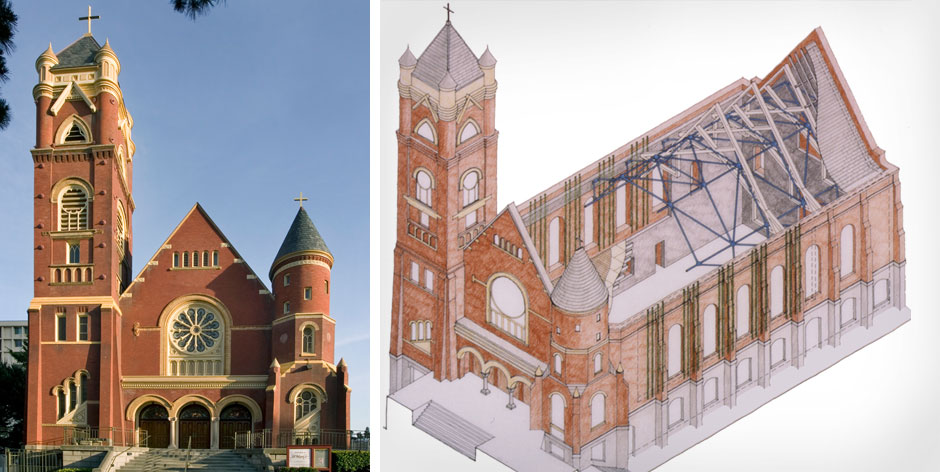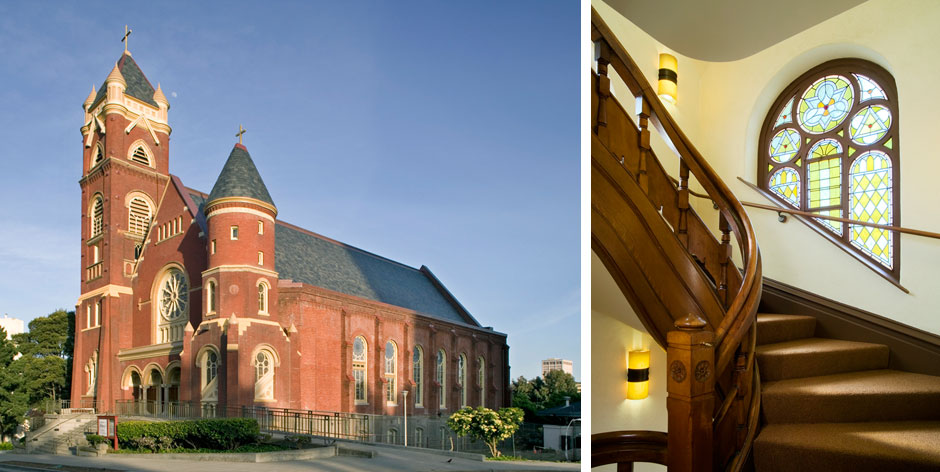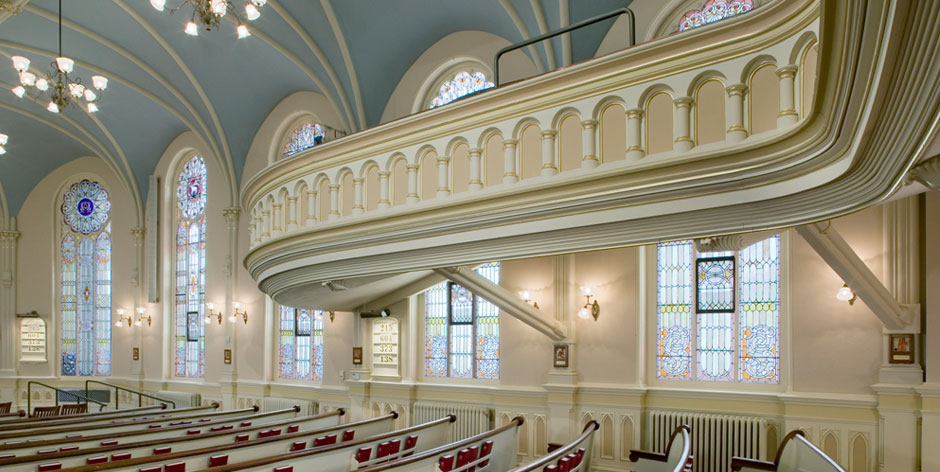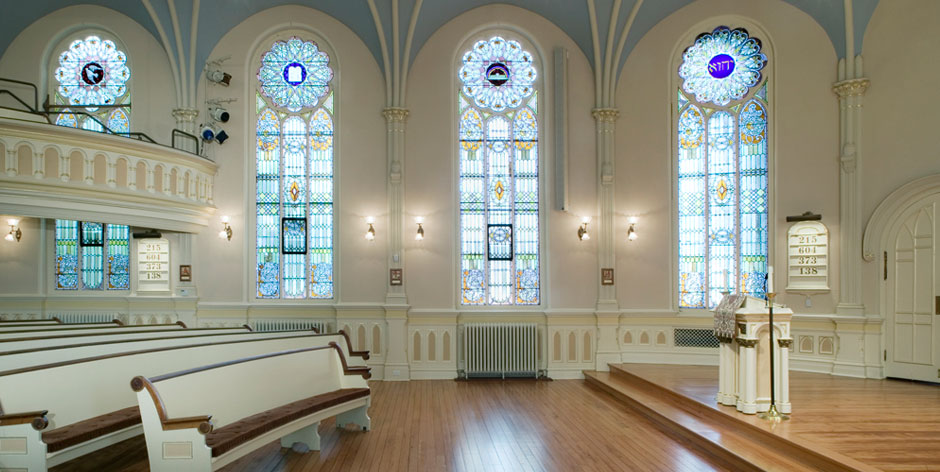Historical Overview
The roots of St. Mark's trace back to 1849 in the California Gold Rush days when the first wave of German immigrants began to arrive in San Francisco. The dedication of the present church building in 1895 marked three decades of effort by German immigrants to establish Lutheranism in California. Rev. Frederick Mooshake from Goettingen University arrived in 1849 to minister to the immigrants. Initially, services were held in homes, then in the Congregational Church of Christ, which was later bought by Rev. Mooshake and his followers, and the First German Evangelical Lutheran Church was formed in 1859.
In 1860 Rev. Jacobus Matthias Beehler arrived to lead the liberal-leaning church, and in 1862 a new church building was constructed on Geary Street facing Union Square. Pastor Beehler resigned in 1867 to form more conservative St. Paulus Lutheran Church at Eddy and Gough. During a tumultuous time there were nine pastors who served St. Mark’s between 1867 and 1883, and for a brief period financial difficulties compelled the church to rent pews for $10 each.
After the succession of pastors between 1867 and 1883, Rev. Julius Fuendeling arrived and stayed for 29 years until 1912. During Pastor Fuendeling’s tenure the present church was constructed on 2 lots on O’Farrell between Franklin and Gough that were bought for $17,500. This church was closer to the Western Addition where many parishioners had moved. The congregation hired a German-American architect, Henry Geilfuss, who designed a red brick church in a blend of Romanesque style and Gothic elements. Three hundred fifty community leaders and onlookers witnessed the cornerstone laying of the new St. Markus, the largest German church in California. The church, which cost $56,000 to build, was dedicated on March 10, 1895. A Schoenstein organ and chandelier from Germany, donated by sugar tycoon Claus Spreckels, were transferred from the Geary St. church to the new St. Markus. During the dedication ceremony St. Mark’s survived the first of many earthquakes.
The name on the cornerstone, St. Markus Kirche, reflected the congregation’s German heritage. The church is a blend of Romanesque and Gothic elements of pointed gables and arches, pier buttresses, and a Rose Window. The red brick is set off by details of buff-colored brick and Bedford stone. The lower tower has an octagonal base with a conical roof, and the higher tower is squared with four upper corner turrets and a pyramidal roof. Other tower features include small arches stained glass windows, diagonal wood moldings and fleur-de-lis patterns. Beautiful stained glass windows were incorporated throughout the architectural design, containing symbols dating from both Jewish and Christian traditions presenting doctrinal concepts.
In 1906 much of San Francisco was destroyed by a devastating earthquake and subsequent fires. The church building was damaged in the major ’06 quake (the east tower was weakened and needed reinforcing) and the church’s cross melted as result of the heat from the fires that swept the city just east on Franklin. The building even survived dynamite explosions that were set off a block away at O’Farrell and Van Ness in an effort to stop the fires. The devastating fires stopped just short of consuming St. Mark’s, and although it barely escaped, the church immediately became a refuge for earthquake victims and sheltered families made homeless by the catastrophe. Through the years the church building survived many minor earthquakes, in addition to the major quakes of 1906 and 1989.
Rev. Fuendeling died in 1912 and was succeeded by Rev. H. S. Feix until 1930, followed by Pastor Oslund, and then Dr. George Dorn from 1942 until 1957.
For several generations, St. Markus had thrived through preservation of Evangelical Lutheranism and the German language and culture. Services were in German until 1932 when English was introduced, and in 1938 the German language was discontinued.
In 1944 the chancel was completely refurbished for the 50th Anniversary of the church. In 1947 the interior was renovated and a new Moeller organ was installed. A few years later there were renovations to the altar, and in 1949 the centennial of St. Mark’s was celebrated. The Ascension window was installed around 1950. Pastor Dorn fit well into the growing popularity of ecumenicalism and was closely linked in the 1950′s to the establishment of Pacific Lutheran Theological Seminary in the Berkeley hills.
As the neighborhood around St. Mark’s declined the congregation elected to stay rather than leave for the suburbs. After 1957, Pastor Ross Hidy led the way to take part in redevelopment of the declining neighborhood, including construction of Martin Luther Tower, devoted to affordable independent living for seniors, and the Urban Life Center with an auditorium, meeting rooms and offices. In 1964 Victorian residences in the vicinity were demolished and the street pattern changed to allow for creation in the late 1960′s of what is now called St. Mark’s Square.
In 1971 in recognition of its historical and architectural significance St. Mark’s was designated San Francisco Registered Landmark #41. A new front entry plaza with ramp, complementing the architectural style, was constructed in 1987.
Following the major Loma Prieta earthquake on October 17, 1989 (the quake destroyed the chandelier brought from the 1863 church), the city mandated that all unreinforced masonry buildings throughout San Francisco must be seismically retrofitted for safety. This requirement began approximately 15 years of many fundraising efforts to completely restore the aging building and retrofit it for earthquake safety. In 1995 Garrison Keillor gave a rousing benefit performance for an early restoration fundraiser. Substantial income came from refinancing Martin Luther Tower (the 121-unit affordable senior housing project built by the church in the mid-sixties), a Thrivent loan, and ongoing capital campaign fundraising. Additionally, scenes for the Hollywood movie “RENT” were filmed in the sanctuary just prior to the church’s closure in June 2005 for the $11 million extensive renovation.
Soon after renovation work began, a time capsule was discovered by a worker under the church foundation. The copper strongbox was in a large sandstone block snuggled under an arched brick niche. On October 9, 2005, the time capsule was opened and provided exciting glimpses into our past. The fragile water-damaged contents included several San Francisco newspapers in German and English, a German hymnal, a German copy of the Augsburg Confession, and 1863 US silver half dollar coin minted in San Francisco. The newspapers were dated 1863, and the time capsule was probably brought from the previous church on Geary Street during construction of the present church. Our church archives indicate there is another time capsule sealed in 1894, probably encased within the old cornerstone of the present church.
The church was closed from June 2005 until December 2006 for the extensive seismic work and restoration. As the congregation continued to hold services in the Urban Life Center auditorium across the plaza, it watched the progress of work on the church building with great anticipation. On December 10th, 2006, the beautifully restored church was reopened and rededicated in a “Fling Wide the Doors” celebration. Despite the many improvements and complete restoration (including, structural systems to withstand quake forces, new slate roof, exterior repairs, expanded Heritage Hall, and new nursery, kitchen, bathrooms, flooring, plumbing, electrical, lighting, audio system, painting, stenciling, gilding, carpet, pew cushions, and magnificent organ) it was obvious that great care had been taken to preserve and restore the exterior and sanctuary much as they appeared in 1895. In honor of this effort, St. Mark’s was awarded a 2007 Preservation Design Award by the California Preservation Foundation.
The tracker organ made by Taylor & Boody Organbuilders in Virginia, which had been installed in the balcony of the sanctuary, was dedicated on March 25, 2007.
With the vision to preserve and restore our 1895 church accomplished, with prayerful trust in the future, and looking forward to years of ministry in this church, a new time capsule was sealed on Reformation Sunday on October 28, 2007, for reopening in fifty years in 2057 by our future sisters and brothers in Christ.
Historical information is from documents and photos courtesy of St. Mark’s Archives. Sources include: “One Hundred Golden Years in San Francisco: A History of St. Mark’s Evangelical Lutheran Church 1849-1949″, Dr. J. George Dorn, 1949; “The Story of St. Mark’s Square” by Rev. Ross Hidy, 1997; “Places in the Neighborhood”, The New Fillmore, June 2000; “A Brief History of St. Mark’s Lutheran Church” by C. VerPlanck 2001?; Heritage News, Jan/Feb., 2001; St. Mark’s Lutheran Church 2006 Annual Report; The Smithsonian magazine, April, 2006.





